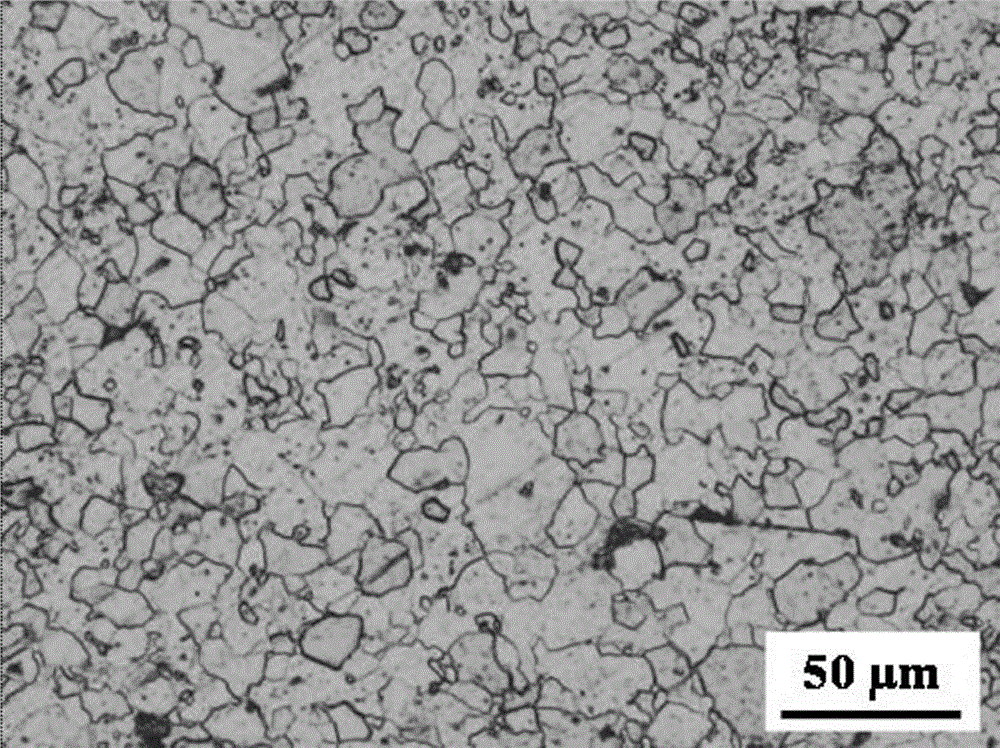Novel biodegradable zinc-based metal material and ureteral expandable stent obtained through material
A base metal and ureter technology, applied in the field of ureteral expansion stents, can solve the problems of difficulty in meeting the requirements of ureteral expansion stents, slow healing of ureteral inner wall tissue, and easy inflammation caused by degradation products, achieving controllable mechanical properties and corrosion properties, and easy adhesion. Attached to the effect of repairing growth and good developability
- Summary
- Abstract
- Description
- Claims
- Application Information
AI Technical Summary
Problems solved by technology
Method used
Image
Examples
Embodiment 1
[0031] A new type of biodegradable zinc-based metal material for ureteral expansion stent, which is composed of Zn, and is prepared from high-purity zinc (≥99.995%). The photo of the metallographic structure of the scaffold material is attached figure 1 shown. The test results of the mechanical properties of the material show that its tensile strength is between 160MPa and 180MPa, and the maximum elongation at room temperature is between 40% and 50%. Therefore, the ureter expansion stent prepared by the material has excellent toughness and deformation ability.
[0032]The stent is composed of wire rods spirally coiled and is in the shape of a dumbbell with both ends enlarged and the middle section is slender. The diameter of the wire rod is 0.1 mm, the middle section 2 of the stent is 20 mm long, and the inner diameter is 2 mm; 120%, the length is 5mm; the pitch of the wire coil is 1mm.
[0033] After a 30-day in vitro degradation test in simulated urine, it was found that ...
Embodiment 2
[0035] A new type of biodegradable zinc-based metal material for ureteral expansion stents, all made of the same zinc alloy, the mass percentage of the zinc alloy is composed of Mg: 0.5%, Cu: 3%, Nd: 0.5%, and the balance is Zn. High-purity zinc (≥99.99 wt.%), high-purity magnesium (≥99.99 wt.%), high-purity copper (≥99.99 wt.%) and high-purity neodymium (≥99.95 wt.%) are used as raw materials. The mechanical performance test results of the material show that its tensile strength is between 330MPa-360MPa, and the maximum elongation at room temperature is between 20%-30%. It can be seen that the ureteral expansion stent made of this material has excellent strength and support performance.
[0036] The stent is composed of intersecting wire rods and is in the shape of a mesh dumbbell with enlarged ends and a slender middle section. The diameter of the wire rod is 0.2 mm, the middle section 2 of the stent is 40 mm long, and the inner diameter is 3 mm; the inner diameter of the e...
Embodiment 3
[0039] A new type of biodegradable zinc-based metal material for ureteral expansion stent, the surface material is zinc alloy, and its mass percentage is Ag: 1.0%, Gd: 2%, and the balance is Zn. The core material is zinc alloy, and its mass percentage is composed of Al: 4%, Ti: 0.1%, and the balance is Zn. The thickness ratio of surface layer material to core material is 4:6. High-purity zinc (≥99.99 wt.%), high-purity silver (≥99.99 wt.%), high-purity gadolinium (≥99.95 wt.%), high-purity aluminum (≥99.99 wt.%), high-purity titanium (≥99.99 wt.%) .%) is prepared from raw materials. The mechanical performance test results of the material show that its tensile strength is between 280MPa-320MPa, and the maximum elongation at room temperature is between 30%-40%. Therefore, the ureter expansion stent prepared by this material has excellent strength and support performance.
[0040] The stent is composed of intersecting wires and is in the shape of a mesh dumbbell with both ends...
PUM
| Property | Measurement | Unit |
|---|---|---|
| diameter | aaaaa | aaaaa |
| tensile strength | aaaaa | aaaaa |
| tensile strength | aaaaa | aaaaa |
Abstract
Description
Claims
Application Information
 Login to View More
Login to View More - R&D
- Intellectual Property
- Life Sciences
- Materials
- Tech Scout
- Unparalleled Data Quality
- Higher Quality Content
- 60% Fewer Hallucinations
Browse by: Latest US Patents, China's latest patents, Technical Efficacy Thesaurus, Application Domain, Technology Topic, Popular Technical Reports.
© 2025 PatSnap. All rights reserved.Legal|Privacy policy|Modern Slavery Act Transparency Statement|Sitemap|About US| Contact US: help@patsnap.com



